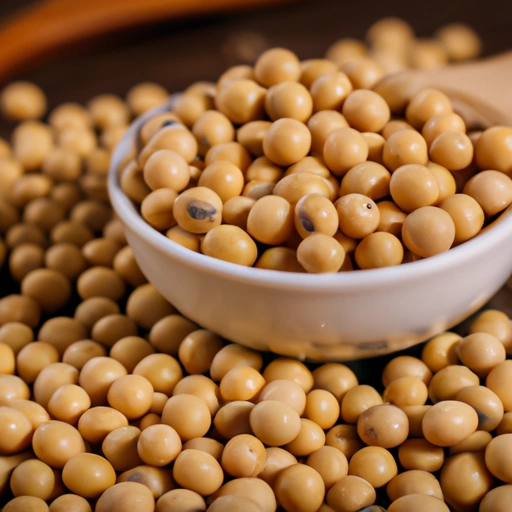Soybean
Description

Soybean, also known as Glycine max, is a species of legume native to East Asia. Widely grown for its edible bean, soybean has become a staple ingredient in various cuisines around the globe. Packed with protein and other essential nutrients, this versatile food item can be found in numerous forms such as whole beans, soy milk, tofu, tempeh, and soy sauce, catering to a range of dietary preferences including vegetarian and vegan diets.
Common uses
Soybeans are widely used as animal feed, in the production of soybean oil, and as a base ingredient for various vegetarian and vegan food products. Additionally, soybeans are also employed in non-food industries for products such as biodiesel and bioplastics.
Nutritional value
Calories
A single cup (approximately 172 grams or 6 ounces) of cooked soybeans contains about 298 kilocalories (kcal).
Protein
That same cup of soybeans boasts around 28.6 grams (g) of protein, making it a rich source of plant-based protein.
Fat
Soybeans contain about 15.4 grams of fat per cup, with a balance of saturated, monounsaturated, and polyunsaturated fats, including essential omega-3 fatty acids.
Carbohydrates
There are about 17.1 grams of carbohydrates in a cup of soybeans, which includes dietary fiber and a low glycemic index.
Vitamins
Soybeans are a good source of B vitamins, particularly folate (B9), and also contain vitamin K.
Minerals
Rich in minerals, soybeans offer calcium, iron, magnesium, phosphorous, potassium, zinc, and selenium.
Health benefits
Consuming soybeans may offer health benefits such as lowering cholesterol levels, improving bone health, and reducing the risk of certain cancers. The isoflavones found in soybeans are also associated with alleviating menopausal symptoms.
Potential risks
While soybeans are generally considered safe for most people, they can cause allergic reactions in some individuals. Additionally, soy contains compounds that can act as goitrogens, potentially affecting thyroid function. Overconsumption of processed soy products is also not recommended due to added sugars and preservatives.
Common recipes
Soybeans are used in recipes such as miso soup, tofu stir-fries, soybean salads, and in the making of soy milk and cheese alternatives. They are also the base for textured vegetable protein (TVP) used in meat substitutes.
Cooking methods
Soybeans can be boiled, steamed, roasted, or fermented. They are often soaked prior to cooking to reduce cooking time and improve digestibility.
Pairing with other ingredients
Soybeans pair well with flavors such as garlic, ginger, sesame, and green onions. They complement grains like rice and vegetables like broccoli and carrots.
Summary
The soybean is a nutrient-dense legume with a rich history and a multitude of culinary applications. Its role in global cuisines is ever-expanding, offering both nutritional value and versatility to chefs and home cooks alike. As an ingredient, it adapts to various cooking methods and dietary needs, making it a staple food for many around the world.